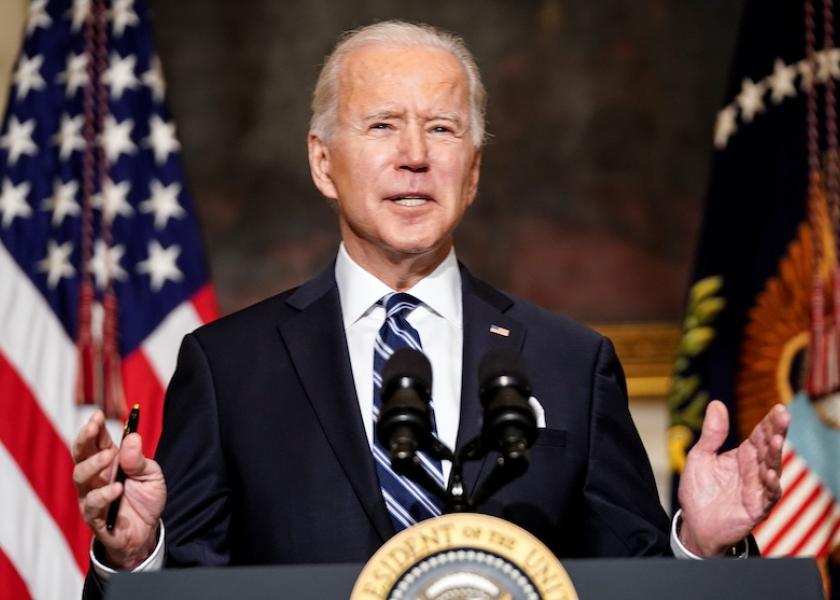Biden Rolls Out $2T Infrastructure Plan, Funding to Fuel Broadband, Roads and Waterways

More than a week after it first made headlines, President Joe Biden is preparing to announce a $2.25 trillion infrastructure plan on Wednesday. The plan is aimed to fuel funding for America’s roads, waterways, broadband and even the electric grid.
It’s called the “American Jobs Plan,” and in a fact sheet released by the White House Wednesday morning, the Biden administration says it will help rebuild the nation’s infrastructure. Which will lead to an economic boom.
But it’s not just rebuilding infrastructure in mind with the plan. There are also initiatives the administration says will help fight climate change and advance racial equity.
“Like great projects of the past, the president’s plan will unify and mobilize the country to meet the great challenges of our time: the climate crisis and the ambitions of an autocratic China,” the administration said in a statement released by the White House.
According to Farm Journal Washington Correspondent Jim Wiesemeyer, highlights of the plan include a list of initiatives, including:
- A $621 billion investment in transportation and resilience, or the construction of infrastructure that can withstand the recent spate of dramatic weather events attributed to climate change.
- “Care infrastructure” spending of $400 billion toward expanding access to care for the aging and those with disabilities, including long-term care services under Medicaid by expanding home and community-based services.
- Invest $100 billion in workforce development programs.
- Include $100 billion in expanding high-speed broadband.
- $100 billion to build a more resilient electric grid.
- $213 billion to build, retrofit and preserve more than two million affordable places to live.
- Spend $100 billion in upgrading and building new public schools, paying for half through direct grants and the other half through bonds.
- Invest $10 billion to modernize and upgrade federal buildings, including through a Federal Capital Revolving Fund.
- $18 billion to modernize Veterans Affairs hospitals and clinics.
- $12 billion for community colleges, including facilities and access.
- $25 billion to upgrade childcare facilities and increase childcare in high-need areas. To address the latter, the president calls for an expanded tax credit to encourage businesses to build childcare facilities at work, with employers receiving 50% of the first $1 million in construction costs per facility.
- A $174 billion investment “to win the EV market,” encouraging automakers to retool their supply chains and factories to accommodate the transition to electric vehicles as well as create sales rebates and tax incentives to buy American-made EVs. White House officials predicted the federal incentives, paired with spending by state and local governments and private companies, would establish a national network of 500,000 charging stations by 2030, while spurring a domestic supply chain that will support union jobs and American-built cars and trucks. The plan also will replace 50,000 diesel transit vehicles, while electrifying at least 20% of the classic yellow bus fleet that transports children to and from school each day.
- $16 billion to employing Americans to plug abandoned oil and gas wells and restore land that has been used for coal, hardrock and uranium mining.
- A $50 billion investment in infrastructure resilience, which would beef up grids, highways and other infrastructure to withstand extreme weather events.
- A $35 billion investment in research into climate science.
- $115 billion to modernize 20,000 miles of highways and roads, rebuild 10,000 of the nation’s most fragile smaller bridges and $85 billion into transit, which would double funding for the program.
- $80 billion for Amtrak’s repair backlog and to upgrade passenger rail service, $25 billion for airports and $17 billion for inland waterways, ports and ferries.
- $111 billion investment to rebuild the nation’s water infrastructure.
- $45 billion in the EPA's Drinking Water State Revolving Fund and Water Infrastructure Improvements for the Nation Act grants and calls for eliminating all lead pipes and service lines — part of about 6 million 10 million homes nationwide and 400,000 schools and childcare facilities. Also calls for investing $56 billion in grants and loans to states to modernize aging wastewater systems.
Plans Comes with a Cost
How will these projects be paid for? Wiesemeyer says there are a series of tax changes Biden is proposing, including the corporate tax rate from 21% to 28%; increasing the global minimum tax paid from about 13% to 21%; ending federal tax breaks for fossil fuel companies; and ramping up tax enforcement against corporations, among other measures.
Biden plans to officially unveil the details of the infrastructure plan during a speech in Pittsburgh Wednesday afternoon.
Related Stories
Critics of Biden's $3T Infrastructure Plan Says It's Too Costly, Not Enough Focus on Infrastructure







